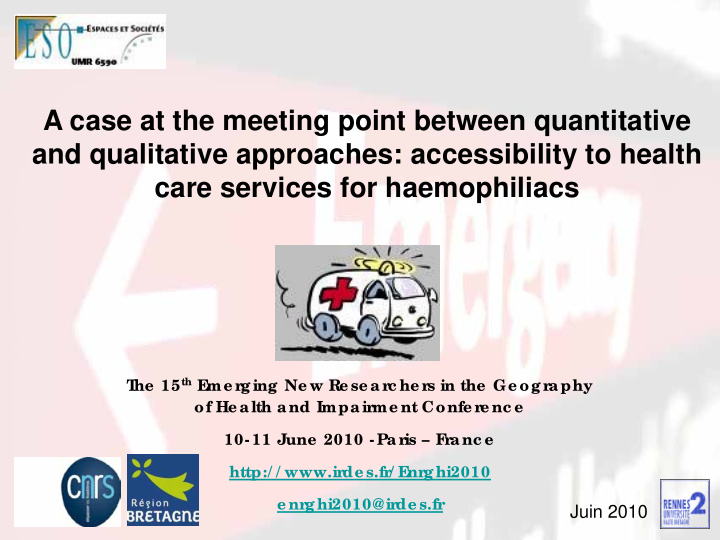



A case at the meeting point between quantitative and qualitative approaches: accessibility to health care services for haemophiliacs he 15 th E T me r ging Ne w Re se ar c he r s in the Ge ogr aphy of He alth and Impair me nt Confe r e nc e 10- 11 June 2010 - Par is – F r anc e http:/ / www.ir de s.fr / E nr ghi2010 e nr ghi2010@ir de s.fr Juin 2010
Introduction 1/ Potential accessibility: distribution of offer and demand of health care 2/ Revealed accessibility 3/ Mix them together to obtain a good (?) meal Conclusion
Components of accessibility in the case of haemophilia Social component : Therapeutical component : -Deprivation -prompt care -Education level -rare facilities -Spatial capital -expensive drugs Accessibility to health services Spatial component : Individual component : -distance - (bad?) experience of the disease, of the treatment -time
1/ Distribution of offer and demand 1.1 Health resources Health ressources for haemophiliacs in Brittany Saint-Brieuc Brest Rennes Lorient Vannes
Travel time from hospitals delivering FVIII or FIX drugs
1.3 Relation between offer and demand Travel time from haemophilia centres
Number of patients contained in each isochrone From all the hospitals 100,0 80,0 60,0 Hémo_min Hémo_sev 40,0 More severe 20,0 haemophiliacs close to 0,0 0-10 10-20 20-30 30-40 40-50 haemophilia centres or small hospitals From haemophilia centres 100,0 80,0 60,0 Hémo_min Hémo_sev 40,0 20,0 0,0 0-10 10-20 20-30 30-40 40-50 50-60 60-70 70-80 80-90 90-100 100-110
2/ Revealed accessibility 2.1 Questionnaire : main marks Questionnaire sent out to all the patients of Brittany (240) : 107 replies (45% of the 240) 70% 60% 50% 40% Questionnaire Brittany 30% 20% 10% 0% Mild Moderate Severe NA 100% 90% 80% 70% 60% Questionnaire 50% Brittany 40% 30% 20% 10% 0% Type A Type B NA
2.2 From revealed accessibility to perception of access Origin of patients followed up in Brittany
Access time to haemophilia centre satisfaction
Reimbursements of journeys for follow up and emergencies
Frequency of journeys to emergency services (in the past year)
Haemophilia as a factor of house location
Haemophilia as a factor of moving
Cases where interviews allow understanding spatial distribution Farid : « We moved to Rennes when they discovered for my HIV, because I go to the hospital very frequently now » Erwan : « I don’t trust in the hospital in my city, they don’t know my disease, I prefer to go directly to Brest [further] »
Case where maps challenge patients’ speeches Most of the patients do not clearly say that the disease has an impact on their housing location. 100,0 80,0 60,0 Hémo_min Hémo_sev 40,0 20,0 0,0 0-10 10-20 20-30 30-40 40-50
Case where new issues are emerging from interviews Haemophilia mobility -because of disability, some haemophiliacs have a low capacity of mobility (crutches, wheelchair) -Patients, especially severe ones, have to always think about their disease. Thierry : « Autonomy. It’s something I developed in relation with haemophilia. I keep in mind the idea that something can happen at any time. I have to be ready to come back home to take my drugs, I don’t want to be dependant on someone » -disease imposes moving and could consequently have a negative impact on accessibility
Attempt to summarize qualitative information from an interview on a map
References (not exhaustive at all ! ) : Curtis S., 2004. Health and inequalities, Geographical perspectives, Sage publications, London Luo W., Wang F., 2003. Measures of spatial accessibility to health care in a GIS environment: synthesis and a case study in the Chicago region. Environment and Planning B: Planning and Design 30:865-884 Moon G., Kearns R., A la recherche d’une nouvelle géographie de la santé In : Fleuret S., Géographie de la santé, 2007, Anthropos, Paris Wang F., Luo W., 2005. Assessing spatial and nonspatial factors for healthcare access: towards an integrated approach to defining health professional shortage areas. Health & Place 11,131-146 Thank you for listening
Recommend
More recommend